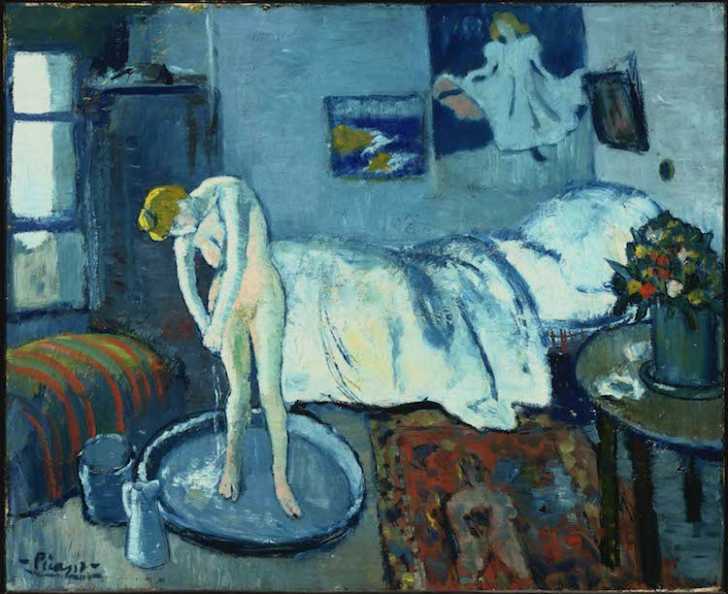Hidden Painting Revealed Underneath Picasso’s ‘The Blue Room’
It had often been suspected that there was a secret painting behind the painting for quite some time, but technology finally proved that theory was true.
They sometimes say that the eyes are the windows to the soul and Pablo Picasso is one who may have agreed with that statement. It seems as if the eyes in his painting were always shifting perspectives, but sometimes it’s necessary to take a look behind the painting to see the true story.
Art historians from The Phillips Collection, Cornell University, the National Gallery of Art, and the Winterthur Museum revealed something interesting in 2014. The Picasso painting, The Blue Room, holds a rather interesting mystery. It had often been suspected that there was a secret painting behind the painting for quite some time, but technology finally proved that theory was true.
Let’s take a look at The Blue Room so we understand more about the theory.
The Blue Room was painted in Paris by Pablo Picasso in 1901. He was 19 years old at the time and had recently entered his Blue period, in which he was more interested in cooler pigments and somber subjects. The Blue Room shows a female bather and is just right for that style.

Picasso had attended the 1900 Paris exposition before he painted The Blue Room. He was able to look at the collection of postimpressionist and impressionist paintings and was inspired to create this masterpiece.
“The work of Degas and Henri de Toulouse-Lautrec exerted a strong influence on this picture,” The Phillips Collection explains. “Picasso’s studio on the boulevard de Clichy provided the setting for this scene of a nude bending over in the tub. Toulouse-Lautrec’s poster May Milton (1895) hangs on the wall as an homage; the artist had passed away on September 1901, shortly before Picasso created this work.”

The Phillips Collection was able to acquire The Blue Room in 1927. It was their first painting by Picasso. The artist had already entered into his surrealist phase, which is more characterized by dreamy figures and unusual facial figures and bodies. The Blue Room was different than his new style, but it was preferred by many as a piece of his earlier work.
Since this was their first Picasso acquisition and one of his earlier pieces, it has always remained a prize possession of the Phillips Collection. They studied it even further in 2014 and now it is back in the spotlight internationally.
In collaboration with Cornell University in New York, the National Gallery of Art in Washington DC, and the Winterthur Museum in Delaware, the Phillips Collection found that there was a hidden image beneath The Blue Room. It is a painting of a bearded man in a bowtie, resting his head in his hand. They feel that the older painting was done just before he painted The Blue Room and the teenage Picasso may not have had enough funds to continue to buy canvas. “Reusing canvases was a common practice for Picasso at the time since he was quite poor,” the Phillips Collection explains.
Nobody knows who the man in the painting was but it has just added another layer to the fame of The Blue Room
The news of the discovery was first heard in 2014 but it was not something that happened overnight. “The collaborative study of Picasso’s The Blue Room has been ongoing for several decades,” the Phillips Collection explained in a press release.
A conservator at the museum noticed inconsistencies in 1954 in the brushwork of that painting. Scientists continued to study the shifts in pigmented texture but it took some time before technology allowed them to see behind it. That happened in 2008, and they finally made the discovery in 2014 in great detail.
It took a team of scientists and some up-to-date technology to uncover the hidden portrait in 1914. They used x-ray fluorescence intensity mapping to trace the pigments.
The National Gallery had also used multi-spectral imaging technology to uncover hidden images in other Picasso paintings so the conservators at the Phillips Collection used an infrared camera with a longwave-pass spectral filter to get a clear picture in 2008. Scientists at Cornell used an XRF detector to supplement those scans in 2012.
Two years later, the participants in the project share their findings at the Phillips Collection “Each of the collaborating conservation scientists and their teams gave short presentations summarizing the results of their analyses,” the museum explains. “Their conversation revealed much about the early Blue Period work, including that the portrait, though unsigned, appears to be a completed picture. Further, the pigments used in both paintings are identical, increasing the likelihood that both were painted by Picasso’s hand.”
The news about the hidden painting in The Blue Room was released on June 17, 2014. It gave a look behind the scenes, so to speak, at the life of Picasso and his early work.
“Our audiences are hungry for this,” Dorothy Kosinski, the Director of the Phillips Collection, said. “It’s kind of detective work. It’s giving them a doorway of access that I think enriches, maybe adds mystery, while allowing them to be part of a piecing together of a puzzle,” she said. “The more we can understand, the greater our appreciation is of its significance in Picasso’s life.”
SKM: below-content placeholderWhizzco for DOT

